28 November 2024
How modern frontend development has evolved? Key trends from the State of Frontend 2020-2025 reports
Without a doubt, the time between 2020 and 2024 has been an exciting period in frontend development history. It started off with a forced move to remote work, quickly followed by the introduction of AI, which was one of the biggest technology changes ever seen. So how did these and other factors influence modern web development? We analyzed the results of our 3 State of Frontend (SOFE) reports from 2020, 2022, and 2024 – the largest studies of the frontend community in the world. Here are our findings based on thousands of responses from developers in 100+ countries.
The transformation of frontend architecture
The frontend architecture landscape has seen numerous changes these past four years. Back in 2020, we already noticed that the introduction of the latest web development technologies accelerated delivery and impacted the way teams collaborated on projects. This included not only internal but also cross-team collaboration, particularly with designers and product owners.
The move from monoliths to micro-frontends
The transition from monolithic to micro-frontend architecture is one of the most apparent trends in web development between 2020 and 2024. Four years ago, around 25% of frontend developers whom we spoke with as part of our SoFE study already had experience using them. About 80% of respondents also believed that these solutions would rise in popularity between 2020 and 23.
Some of the ‘big players’ who grew their investment in micro-frontends during this time included IKEA and American Express.
But pure usage statistics aside, what drove this change in the first place? The most important factor was that micro-frontends allowed developers to work more independently than with monolithic architectures. This often translated into better team collaboration, project scalability, and – ultimately – faster delivery speed.
In 2020, micro-frontend frameworks like Single-SPA and Module Federation were already emerging on the horizon. By the time we published our 2022 report, both frameworks had matured, with Single-SPA becoming the most popular (used by 35.9% of respondents).
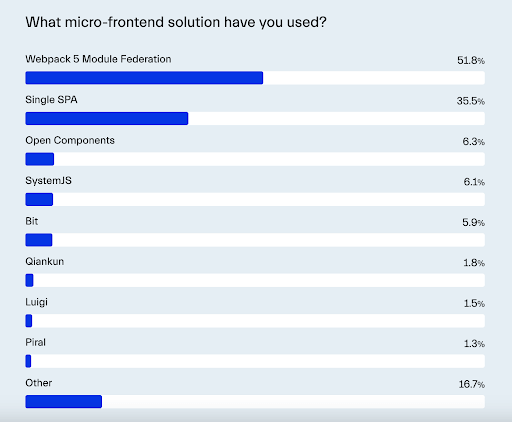
By 2024, Single-SPA’s popularity was dethroned by Module Federation, which became the most used micro-frontend framework, at a 51.8% usage rate.
Micro-frontends continue to be a popular architectural choice, and our findings suggest they will shape the near future of web development. That said, we’ve noticed a mental shift between our 2022 and 2024 State of Frontend editions.
In the early days of micro-frontend adoption, companies believed that these frameworks would absolutely reduce development costs. Unfortunately, some organizations invested in micro-frontends without fully understanding the necessary organizational and cultural changes that would need to follow. That’s where many hidden costs, like team restructuring and realignment, came to light.
As 2024 comes to an end, it’s worth observing how the micro-frontend landscape will continue to evolve – particularly with AI integration and new frameworks like Piral now entering the picture.
Team structure evolution in frontend development
Many changes in terms of team structure took place between 2020 and 2024. They were mainly driven by evolving technology, the shift to remote work, and architectural advancements. Here’s a quick overview.
Shift from generalist to specialist roles
In 2020, frontend developers were part of larger, collaborative teams and usually had to wear multiple hats as their roles were broader than they are now. They also had more independence as Jamstack architecture allowed for quicker deployment of frontend projects without full backend involvement.
By 2022, more specialist roles started to emerge, with titles like ‘frontend development architect’ and ‘design system director’. This signaled a shift to more segmented teams, with developers focusing on specific layers of the frontend stack or bridging a few areas like design and development.
2024 confirmed that the future of frontend development lies in specialization, with programmers becoming responsible for full-stack contributions like backend and testing. Today, developers are more versatile, and able to manage the entire project lifecycle — from design to deployment — which signals an increasing integration of frontend and backend.
Remote work has impacted team structure and collaboration
One of the biggest changes we see in development is in team structure and how teams work. In 2020, teams were primarily office-based, which made collaboration between different team members more seamless. After the COVID-19 pandemic outbreak, businesses were forced to start operating remotely.
In 2022, remote work became the new norm, with 56% of developers based outside of the office. This shift introduced challenges in communication and collaboration, and has pushed development teams into using new sets of tools in an attempt to facilitate remote work.
In 2024, some companies began to ask their employees to return to offices, with a lot of businesses still operating either fully remotely or in a hybrid model. 44.5% of the developers we surveyed said they were home-based, while 42.7% worked in a hybrid model. Only 12.9% of programmers were fully on-site. It looks like remote work is here to stay, so future skills in tech will definitely include a blend of technical expertise, good communication, and self-management skills.
Changes in team size and composition caused by architectural evolution
In 2020, frontend teams became more independent from the backend thanks to advancements in frontend architecture, which allowed developers to deploy without waiting for backend tests. This was also a year of explosive hiring as companies scaled to meet increased demand for online services and products caused by the lockdown.
By 2022, 50% of developers we surveyed said they worked in a team of 10 or more. At the same time, 27% were part of a team of 50 or larger. The growth in team size happened alongside the expansion of complex architectures like Jamstack. In 2024, we saw the number of full-stack developers grow, as over 33% of programmers we spoke to identified as full-stack. This shift has led to more dynamic team structures, and developers are now able to handle both frontend and backend responsibilities.
Web development new trends – over 30% of developers surveyed in 2024 identify as full-stack
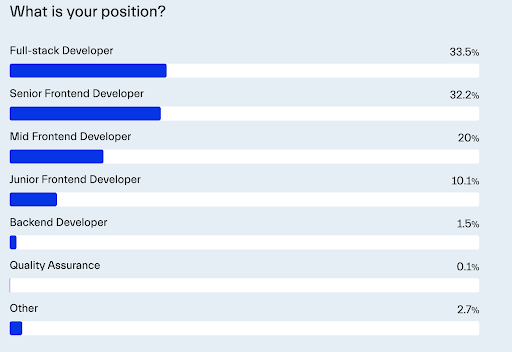
Evolution of frontend leadership roles
As you can imagine, changes in team composition also called for a change in frontend leadership. Back in 2020, frontend developers cooperated closely with designers, product owners, and DevOps engineers. However, by 2022, roles like “frontend development architect” emerged, which showed the growing need for leaders to organize complex frontend systems.
What is interesting to see is the number of senior developers growing in 2024, with over 32% classifying as senior as opposed to 28.6% in 2022. This shows a shift towards experienced leaders able to manage teams of senior employees with full-stack capabilities. Since remote work isn’t going anywhere, remote team management is yet another skill that modern leaders must have in their portfolio.
How the technology stack matured
Between 2020 and 2024, the technology stack’s evolution was characterized by a mix of established technologies strengthening their foothold and the emergence of new frameworks, tools, and testing patterns. Additionally, factors like remote work and economic uncertainty also influenced tech stack choices.
React remained on top, but new frameworks also entered the picture
In 2020, React firmly held its place as the dominant framework, used by 74.2% of frontend developers. It had more users than the two runner-ups, Angular and Vue.js, combined. We also accurately predicted that Svelte, an emerging new player, would become a popular, leaner alternative for smaller applications. By 2022, nearly half of respondents said they wanted to learn to use it.
2022 also saw a growing interest in meta frameworks like Gatsby and headless CMS. Component-driven development also became essential due to the rising importance of accessibility and user experience.
In 2024, React and Next.js maintained their lead. The former was used by 69.9% of respondents, while the React-based rendering framework secured a 52.9% usage rate.
Simultaneously, frameworks like Astro, SvelteKit, and SolidJS also gained traction. While they might not dethrone React/Next.js anytime soon, the traits they’re appreciated for—i.e., island architecture and enhanced reusability—could influence the future of frontend development frameworks.
The evolution of building tools and their impact on development efficiency
In 2020, we already reported on a trend towards making JavaScript-based build tools more developer-friendly.
By 2022, this focus expanded with the introduction of modern, zero-configuration tools like Vite, which promised faster build times and hot-reloading. 1 in 4 developers reported using it that year. Vite leverages esbuild to simplify the developer experience, quickly gaining popularity as an alternative to Webpack, which remained popular but was often criticized for its complexity.
By 2024, Vite continued its rise, with 82.4% of developers expressing satisfaction. Webpack paled in comparison with a score of just 44%.
Testing became a frontend developer’s responsibility
Developers’ involvement in software testing was already high in 2020, with 80% of respondents admitting that they performed them as part of their work. To help manage their growing codebases, teams commonly used tools like RSpec and Capybara for unit, end-to-end, and integration tests.
By 2022, testing responsibilities had further shifted towards developers. Almost 1 in 4 developers ran tests independently, while 43.4% said they handled them alongside QA teams. Unit testing was the most popular, performed by 91% of survey respondents.
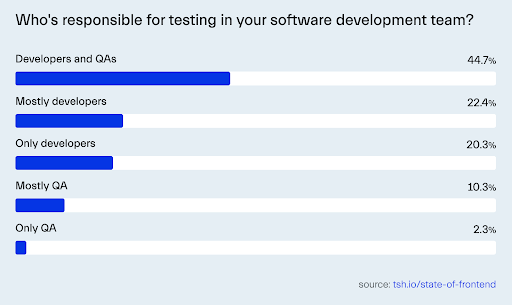
The importance of testing remained strong in 2024, with 77.8% of frontend developers running tests throughout the year. Vitest and Playwright emerged as powerful alternatives to Jest and Cypress among the tools used for this purpose.
Stronger focus on performance as a business factor
Our 2022 report evidently focused on user experience and performance. This was the result of at least two major factors: Google’s growing emphasis on application speed as a ranking factor and the emergence of website accessibility laws. To build faster, user-friendly applications, developers relied on tried-and-tested frameworks like Next.js (used by 43.6% of respondents) and new ones like Gatsby (22.7%).
By 2024, server-side rendering (SSR) and static site generation (SSG) became crucial. Next.js continued leading the charge as the framework used for SEO and application speed. The rise of React Server Components (RSC) and Actions in React 19 also enhanced performance and allowed for more efficient server-client interactions.
A shift in factors influencing investment decisions
In 2020, tech team leaders were increasingly concerned about the increasing complexity of frontend development. The pandemic and the enforcement of remote work during lockdown only added to this challenge. Businesses commonly invest in technologies like TypeScript (used by 77.2% of developers) and modern testing tools to ensure code stability and minimize project risks.
By 2022, investment shifted more towards meta frameworks and tools that supported app performance and UX best practices. 63% of developers acknowledged the rising importance of accessibility, with meta frameworks like Angular, Nuxt, and Next offering different ways of solving usability challenges.
In 2024, accessibility and end-user experience remained key business priorities, but with the introduction of AI tools, more emphasis was placed on AI integration. Additionally, we noticed more investment in productivity tools like Vite and Playwright, emphasizing efficiency and scalability as important decision-making factors.
Growing TypeScript popularity
Between 2020 and 2024, TypeScript became one of the dominant web development technologies and is now considered a critical part of the modern JavaScript ecosystem. It’s safe to say that it has transformed the way developers approach frontend projects, leading to enhanced development efficiency, code reliability, and developer experience.
In 2020, 77.2% of developers used TypeScript over plain JavaScript, showing that it was gaining significant traction. Even developers who used established frameworks like React and Angular or newer ones, like Stencil and Dojo, turned to TypeScript for its ability to reduce or prevent common JavaScript bugs. Its compile-time error detection streamlined the debugging process. Although 4 years ago, 14% of developers doubted TypeScript’s longevity, it was already on the path to becoming a standard for the new-frontend. It was all thanks to features like auto-completion, type inference, and better code navigation.
By 2022, TypeScript’s adoption had skyrocketed to 84%, making it an inseparable element of modern frontend development and significantly reducing JavaScript’s development frustrations. It became hard to find modern projects without TypeScript, and it’s no wonder since it made the development process much smoother and more reliable.
In 2024, TypeScript’s adoption reached its peak, with over 90% of developers using it and 53% seeing it as the future of web development. As more programmers turned to TypeScript, they identified a growing need to enhance its type-checking speed. Developers explored tools like oxc and natively built solutions to maintain efficient development cycles.
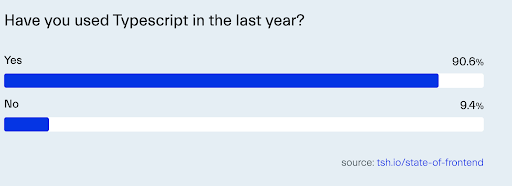
Programmers valued TypeScript not just for its type-checking abilities but also for improving the overall developer experience thanks to enhanced code completion, linting, and type-safe APIs across frameworks.
Frontend performance: Then and now
Between 2020 and 2024, the approach to frontend performance evolved significantly, with new metrics, optimization strategies, and tools that reshaped development practices.
In 2020, we observed a growing popularity of Jamstack architecture. About a third of all respondents told us they used it in their work that year.
The solution allowed developers to pre-render pages before request time and improve performance by using Content Delivery Networks (CDNs). It became a popular choice because it helped reduce performance budgets by cutting server load time and accelerating static content delivery. In addition to filling the market need for faster websites, Jamstack also lowered maintenance overhead.
Google introduced Core Web Vitals in 2021, three performance metrics that are still important today: Largest Contentful Paint (LCP), First Input Delay (FID), and Cumulative Layout Shift (CLS). Frontend teams needed to prioritize these new SEO ranking standards in their work, which significantly impacted their build practices.
They commonly focused on using “lighter” frontend frameworks, optimizing asset loading, reducing layout shifts, and improving page interactivity.
By 2022, Core Web Vitals became the industry standard, leading to more precise performance budgeting as companies knew what metrics to focus on. The performance goals circled around LCP, FID, and CLS. To stay within budget, developers implemented tools like lazy loading, asynchronous scripts, and efficient image handling. The stronger focus on performance stemmed not only from the drive to enhance user experience—although that aspect was also key—but primarily from the need to boost SEO rankings.
Better performance translates into increased visibility on Google and, ultimately, more revenue. This correlation between web performance and positioning probably acted as a wake-up call for many developers in 2022, as only 10.4% admitted to always taking care of the application’s SEO, while 28% said they never did.
Fast forward to 2024, and performance optimization goes way beyond meeting technical metrics. It is now closely linked to revenue generation. This ‘realization’ has changed developers’ approach to both performance and SEO. Among the programmers we surveyed, 81.3% believed the importance of performance would continue to grow, and 54.8% saw SEO as an increasing priority.
Companies started to see faster websites as a way to enhance conversions and the bottom line, treating Core Web Vitals as key revenue indicators. This shift motivated businesses to invest in performance tools and frameworks. For example, React’s ecosystem included features to boost performance, with full-stack frameworks allowing for faster server-side rendering. This has reduced the need for spinners, which smoothened user experiences and made them more responsive.
Mobile-first evolution
The shift towards a mobile-first frontend development strategy has evolved from “just” a competitive edge to a necessity – particularly between 2020 and 2024. Calling it one of the most important technology trends of the early-2020s would be no overstatement.
In just four years, the global number of mobile users rose from 6.9 billion in 2020 to more than 7.4 billion in 2024. Since Q1 2020, mobile devices have also accounted for more than half of total global web traffic.
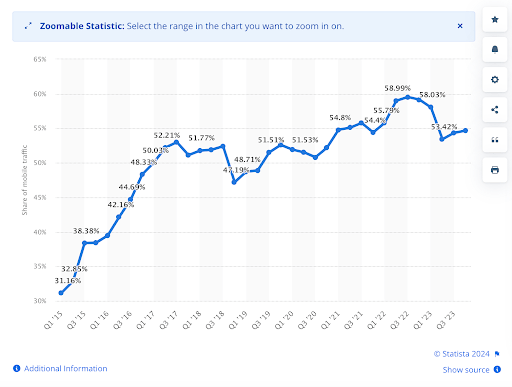
Google noted the growing popularity of mobile search in the mid-2010s, announcing in 2016 that it would eventually move to mobile-first indexing. The switch was finalized in July 2024, and almost all sites are now crawled and indexed with a smartphone crawler.
Companies were well aware of this ongoing change in 2020. Initially, designers and developers turned to responsive designs, making sure that sites would scale properly across various screen sizes. Over time, the approach evolved into component-based, adaptive designs. Today’s frameworks prioritize flexible, modular components that adjust seamlessly across devices, enhancing user experience.
Unsurprisingly, the approach to app testing has also changed. Developers and QAs now run extensive mobile-specific tests like cross-browser compatibility and end-to-end tests on multiple platforms. To make sure they replicate real-life user experiences, they commonly turn to emulators and simulators. Automated testing tools like LambdaTest and Appium have also started playing a larger role
Strategic decision-making in frontend work
The days of ad hoc, informal reviews are gone. Risk assessment has become a lot more structured and proactive. Years ago, developers mainly focused on testing for issues like browser compatibility and performance. Over time, testing went beyond basics and started to focus more on security vulnerabilities (e.g., XSS attacks), scalability, and dependency management.
Currently, risk assessment involves a lot more automation, which makes the process both faster and more accurate. Tools like Snyk and GitHub Dependabot can scan for vulnerabilities and assess the risks in 3rd party libraries.
A shift in risk assessment has also changed how teams manage technical debt. It’s no longer an afterthought but an integral part of software development. In the past, technical debt was ignored until it led to a bigger problem. Today, teams turn to strategies like continuous refactoring and use automation tools like SonarQube to verify code quality. Agile practices also allow product teams to continuously assess technical debt and address it in sprints instead of waiting for it to accumulate.
The approach to ROI calculation for frontend development has also changed — from basic cost-benefit analyses focused on speed and aesthetics to more complex analyses focused on UX and performance metrics. Initially, ROI mainly reflected time and cost savings from using tools and frameworks. Nowadays, companies focus a lot more on the impact of frontend on conversion rates, user retention, and SEO rankings. Metrics like Time to Interactive (TTI), bounce rates, and accessibility are now part of the modern ROI framework as they directly affect both revenue and customer satisfaction.
Future-proofing frontend operations
If there’s one way to sum up these last 4 years in frontend development, then it would be a story of ongoing adjustments to new market conditions and new web development technologies. Modern web development nowadays goes way beyond technicalities. Leaders must prioritize high app performance, accessibility, and good user experience across all devices.
There’s also the case of AI and how it will affect future tech careers in software development. We believe that front-end developers should stop worrying about AI potentially taking away their jobs and instead shift their focus to how they can use it to improve their work output.
It’s going to be an interesting few years. We’ll surely report on what happens in the next edition of the State of Frontend report, so stay put.
See better metrics and higher user activity after React optimization
During a two-week sprint, our team will review 48 performance issue types in React, spot bottlenecks, and develop a detailed improvement plan. We’ve been doing this for over 10 years, so your frontend is in safe hands!

